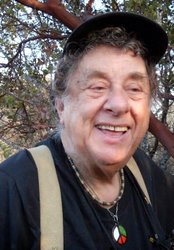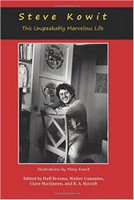—after Steve Kowit
The power of the atomic nucleus
Harnessed by these hands:
Hands that wipe runny noses
And sign report cards,
Hands that changed five thousand diapers
And one husband.
Think of it! A star, an earth-bound sun
Within a bottle!
A limitless energy for the planet,
Dynamic, cleansing and pure.
No more fossil fuels, no exhaust fumes,
No soot-filled skies,
No more Greenhouse effect,
No melting of polar ice caps.
These hands will save
The rainforests, the Amazon, the deserts,
The Arctic, the oceans,
All the Prince William Sounds.
These hands will save our children,
The haves and have-nots.
Yes, I, ex-housewife, will change
The course of human history!
My name will become synonymous
With Promethean courage and zeal.
I will take my place among
The gods of antiquity, immortalized!
And in the golden shrine of Lisa—
Goddess of Fusion, Starmaker—
Scientist and skeptic alike
Kneel in supplication at the altar
And gaze, awestruck,
At the hands of the Redeemer
...set in bronze.
—Previously published under author’s former name, Lisa M. Smith, in
Firstdraft (1989-1990), the Grossmont College literary magazine
Thirty years ago, I was fortunate to take two writing courses taught by the
incomparable Steve Kowit, may his sweet soul rest in p☮ace. The
unwittingly prescient “Fusion in a Mason Jar” above was inspired
by Steve’s assignment for us to write a funny or self-deprecating
poem, making liberal use of hyperbole, and by my reactions to current events
in 1989: the alleged achievement of cold fusion (i.e., room-temperature nuclear
fission, in a jar) and the Exxon-Valdez oil spill, the devastating environmental
disaster in Prince William Sound, Alaska.
While the tongue-in-cheek tone of my poem was initially an effort to mimic
Steve’s style, it gathered steam in response to the scorn from scientists
(including my beloved at the time, a mathematician studying physics) after no
one could replicate the Fleischmann–Pons experiment. Despite their disgrace
and discreditation, I felt that cold fusion had huge potential, that it could
solve so many of humanity’s problems thus bringing us salvation on the
global scale.
|
|

Click on image...
From the Foreword review of Steve Kowit’s book The
Dumbbell Nebula (1999):
“...many of the poems take
a hyperbolic swing at the speaker’s own ego, with hilarious
effect.”
|
Three decades later, I’m less idealistic about human nature and our ability
to resolve or even mitigate the most pressing of our problems—climate
change—which I think we should call The Climate Emergency:
this quagmire of environmental crises precipitated by human activity that now
threatens all life on the planet.
For more than six decades, research into nuclear fusion has continued. Our government has spent an estimated $30 billion on fusion energy science since 1953 (“Weighing the Cost of Big Science” by Richard Martin, in MIT Technology Review, 22 September 2015). Projects like Germany’s Wendelstein 7-X stellarator “hot fusion” reactor, and Google+Tri Alpha Energy’s plasma generators in California, have been making news lately. But actually achieving nuclear fusion is still years away—as it has been for decades!
To my mind, these “hot fusion” projects also seem dicey because it requires mind-boggling amounts of energy in order to produce small amounts of energy for a limited time. And, just as important, scientists still don’t know enough about the process to have a clear idea of what the potential downsides and dangers may be.
I remain hopeful about the potentials of LENR (low energy nuclear reactions), as cold fusion came to be known after its name had been discredited. Research in that arena has increased, though more quietly. Still, it’s likely that I will join treasured friends like Steve Kowit in the hereafter before fusion, in a mason jar or otherwise, is ever achieved by humans.
 Click on image...
Click on image...
is co-editor and publisher of the KYSO Flash online literary journal, and served as webmaster and associate editor for Serving House Journal from its inception in January 2010 through its retirement in May 2018, after publishing 18 issues. She is a co-editor of Steve Kowit: This Unspeakably Marvelous Life (Serving House Books, 2015), and the editor, designer, and publisher of ten books for her KYSO Flash micro press.
In 2017, she began serving on the General Advisory Board for The Best Small Fictions, published by Braddock Avenue Books. For the 2016 edition, published by Queen’s Ferry Press, she served as Assistant Editor, Domestic.
MacQueen’s short fiction, essays, and poetry appear in Firstdraft, Bricolage, Serving House Journal, and New Flash Fiction Review, and her essays appear in the anthologies Best New Writing 2007 and Winter Tales II: Women on the Art of Aging. Her nonfiction won an Eric Hoffer Best New Writing Editor’s Choice Award and was nominated twice for a Pushcart Prize.
⚡
The Fortune
You Seek Lies in a Different Cookie, fiction in New Flash Fiction Review
(Issue 10, January 2018)
⚡
Tasting the New, micro-fiction in Serving House Journal
(Issue 1, Spring 2010)
⚡
A Visit
with the Bee-Headed Monster of the Black Lagoon, an article in Beelines
(May 2013, pp. 5–7) based on MacQueen’s phone interview with author and
retired English teacher, Terry Johnson, who has kept bees for more than 50 years
⚡
Clan
Apis: A “Comic Book” by Jay Hostler, MacQueen’s review of the
remarkable, genre-bending, award-winning book in Beelines (July 2013, pg. 8);
also appearing on page 8 of that issue, photos of her bees feeding on honey

